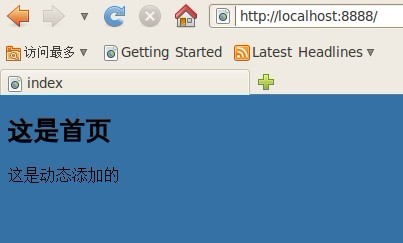node.js 一個簡單的頁面輸出實現代碼
編輯:關於JavaScript
復制代碼 代碼如下:
console.log("hello node.js")
for(var i in console){
console.log(i+" "+console[i])
}
node example.js。
你千萬不要在node.js使用alert進行調試,那是浏覽器帶的全局方法,不報錯才怪。
輸出結果如下:
復制代碼 代碼如下:
var log = function () {
process.stdout.write(format.apply(this, arguments) + '\n');
}
var info = function () {
process.stdout.write(format.apply(this, arguments) + '\n');
}
var warn = function () {
writeError(format.apply(this, arguments) + '\n');
}
var error = function () {
writeError(format.apply(this, arguments) + '\n');
}
var dir = function (object) {
var util = require('util');
process.stdout.write(util.inspect(object) + '\n');
}
var time = function (label) {
times[label] = Date.now();
}
var timeEnd = function (label) {
var duration = Date.now() - times[label];
exports.log('undefined: NaNms', label, duration);
}
var trace = function (label) {
// TODO probably can to do this better with V8's debug object once that is
// exposed.
var err = new Error;
err.name = 'Trace';
err.message = label || '';
Error.captureStackTrace(err, arguments.callee);
console.error(err.stack);
}
var assert = function (expression) {
if (!expression) {
var arr = Array.prototype.slice.call(arguments, 1);
require('assert').ok(false, format.apply(this, arr));
}
}
通過這些函數,我們大概了解到node.js在全局作用域添加了些什麼,如require, process。但也不能武斷說是,因為它們可能是某個作用域的私有對象。不過,了解這些全局對象,並從這些對象上出發去了解其他對象,非常有助於我們了解node.js的生態結構。在前端,每當浏覽器升級,我就遍歷一下window對象以及其個元素節點就得知它又增加了什麼方法與屬性,然後再查文檔。那些更新日志不可能把全部細節都告訴你的,必須自己動手遍歷一下,這樣你就比別人知道得更多。好了,我們去找node.js的全局對象。
node.js的文檔告訴我們,有如下幾個全局對象:
global, process, require,__filename,__dirname, module
但我們為什麼能直接使用console.log呢?經驗告訴我們,console肯定是某全局對象的成員,正如我們可以alert, 也可以window.alert。好了,我們選遍歷一下global這個名字取得非常霸氣的對象
復制代碼 代碼如下:
for(var i in global){
console.log("var " + i+" = "+global[i])
}
結果如下:
復制代碼 代碼如下:
var global = [object global]
var process = [object EventEmitter]
var GLOBAL = [object global]
var root = [object global]
var Buffer = function Buffer(subject, encoding, offset) {
//太長了,省略
}
var setTimeout = function () {
var t = NativeModule.require('timers');
return t.setTimeout.apply(this, arguments);
}
var setInterval = function () {
var t = NativeModule.require('timers');
return t.setInterval.apply(this, arguments);
}
var clearTimeout = function () {
var t = NativeModule.require('timers');
return t.clearTimeout.apply(this, arguments);
}
var clearInterval = function () {
var t = NativeModule.require('timers');
return t.clearInterval.apply(this, arguments);
}
var console = [object Object]
發現global與浏覽器的window一樣,都有個指向自身的同名成員。window === window.window, global === global.global。但node.js早期設計得不好,又一搞了個多余的GLOBAL成員。
console.log(global === global.global)//true
console.log(global === global.GLOBAL)//true
我們再遍歷module對象:
復制代碼 代碼如下:
for(var i in module){
console.log("var " + i + " = "+module[i])
}
結果如下:
復制代碼 代碼如下:
var id = .
var exports = [object Object]
var parent = null
var filename = /home/cheng19840218/node/example.js
var loaded = false
var exited = false
var children =
var paths = /home/cheng19840218/node/node_modules,/home/cheng19840218/node_modules,/home/node_modules,/node_modules
var load = function (filename) {
//太長了,省略
}
var _compile = function (content, filename) {
//太長了,省略
}
原來那個著名的exports是在此提供的,__filename大概也是filename的引用。只要遍歷一下,你就發現許多有趣的東西。但別以為一下秘密就暴光在你眼皮下,還有許多不可遍歷屬性。比如上面我遍歷global對象,只有尞尞可數幾個成員,我們可以使用ecma262v5新增的方法去考察一下:
console.log(Object.getOwnPropertyNames(global))
結果如下:
復制代碼 代碼如下:
[ 'clearInterval',
'TypeError',
'decodeURI',
'Buffer',
'parseFloat',
'Number',
'URIError',
'encodeURIComponent',
'RangeError',
'ReferenceError',
'RegExp',
'Array',
'isNaN',
'setTimeout',
'console',
'Date',
'Infinity',
'Boolean',
'Error',
'root',
'NaN',
'String',
'Function',
'Math',
'undefined',
'encodeURI',
'escape',
'unescape',
'process',
'decodeURIComponent',
'EvalError',
'clearTimeout',
'GLOBAL',
'setInterval',
'SyntaxError',
'Object',
'eval',
'global',
'parseInt',
'JSON',
'isFinite' ]
許多人學node.js就立即看其文檔,殊不知node.js本身所依賴的V8引擎就擁有許多要學的東西,這其中包括ecma262v5帶來的新方法新對象,還有效仿firefox的一些語法:
__defineGetter__
__defineSetter__
__lookupGetter__
__lookupSetter__
set
get
__proto__
不過以"__"開頭的東西我是不建議用的,像set與get現在最新的浏覽器都支持,如IE9,可以在其開發人員工具下試試下面的腳本:
復制代碼 代碼如下:
var a = {
get latest () {
if (this.log.length > 0) {
return this.log[this.log.length - 1];
}
else {
return null;
}
},
log: []
}
a.log[0] = "a";
a.log[1] = "b";
console.log(a.latest)
在node.js基本上沒有兼容問題(如果你不是從早期的node.js玩起來),而且原生對象又加了這麼多擴展,再加上node.js自帶的庫,每個模塊都提供了花樣繁多的API,如果還嫌不夠,github上還有上千個插件。對於想向嘗試一下後端編程的JSer來說,這是極具誘惑力的。可能有人說,後端不是涉及數據庫操作嗎?這與比前端的DOM兼容比起來,不值一提。還有什麼文件夾與文件操作 ,你就當成是一種特殊的數組操作就是。因此你完全可以憤憤不平!
好了,我們來點實質的內容吧。node.js本來就是一個http服務器,它是要與前端交互的,因此少不了兩個對象:請求(request)與響應(response)。請求與響應顯然一種異步的東西,因為我們 不知道前端什麼時候發請求過來,響應也不能立即給前端,還要做日志,讀寫數據庫等操作呢。因此對於javascript來說,這用回調函數來實現最好。那麼由誰來接受這個回調呢?一個服務器對象!
復制代碼 代碼如下:
var http = require("http");
http.createServer(function(request, response) {
response.writeHead(200, {"Content-Type": "text/plain"});
response.write("Hello node.js");
response.end();
}).listen(8888);
node.js有個特殊的require,用於同步加載其他模塊的對象,這與其他語言的require, import差不多。能同步就是好,不像前端那樣一層套一層。然後利用一個函數去實例化一個服務器對象,然後監聽8888端口。這是node.js官網最初的例子,大家都寫爛了。但這樣的程序在現實中一無是處,我們在地址欄上輸入URL,你起碼要返回一個完整頁面給我吧!
對此,我們首先要進行模塊化。模塊化是以文件為單位的,把example.js更名為server.js,然後再把裡面的內容改為一個模塊。對於一個node.js的文件,其實它裡面的內容是在一個封閉的環境中執行。要想共享給其他模塊使用,就必須綁定在exports對象上。
復制代碼 代碼如下:
var http = require("http");
exports.start = function(){
http.createServer(function(request, response) {
console.log("Request received...");
response.writeHead(200, {"Content-Type": "text/plain"});
response.write("Hello node.js");
response.end();
}).listen(8888);
console.log("server start...");
}
然後我們再建一個index.js作為入口(index.js與server.js放在同一目錄下)。
復制代碼 代碼如下:
var server = require("./server");
server.start();
然後建一個index.html頁面。
復制代碼 代碼如下:
<!doctype html>
<html>
<head>
<title>index</title>
<meta content="IE=8" http-equiv="X-UA-Compatible"/>
<meta http-equiv="Content-Type" content="text/html; charset=UTF-8">
</head>
<body>
<h2>這是首頁</h2>
</body>
</html>
現在我們就在要請求過來時,把此頁的內容讀出來,返給用戶。這時我們就要用到fs模塊的方法了。
復制代碼 代碼如下:
var http = require("http");
var fs = require('fs');
exports.start = function(){
http.createServer(function(request, response) {
fs.readFile('./index.html', 'utf-8',function (err, data) {//讀取內容
if (err) throw err;
response.writeHead(200, {"Content-Type": "text/html"});//注意這裡
response.write(data);
response.end();
});
}).listen(8888);
console.log("server start...");
}
好了,這時我們重啟再次輸入地址,就看到一個完整的頁面了。
但一個頁面除了HTML結構層外,還有javascript與css。那麼,我們在當前目錄建一個文件夾javascripts, 裡面建index.js,內容如下:
復制代碼 代碼如下:
window.onload = function(){
var p = document.createElement("p");
p.innerHTML = "這是動態添加的"
document.body.appendChild(p);
}
再建一個styles目錄,裡面建index.css,內容如下:
復制代碼 代碼如下:
html,body{
background: #3671A5;
height: 100%
}
然後在index.html引入這兩個文件:
復制代碼 代碼如下:
<!doctype html>
<html>
<head>
<title>index</title>
<meta content="IE=8" http-equiv="X-UA-Compatible"/>
<meta http-equiv="Content-Type" content="text/html; charset=UTF-8">
<link type="text/css" rel="stylesheet" href="styles/index.css"/>
<script src="/javascripts/index.js"></script>
</head>
<body>
<h2>這是首頁</h2>
</body>
</html>
重新打開,發現沒有改變,google,說要處理js與css文件的請求。沒有辦法,取得request.url屬性,再判定後綴名,為它進行文件讀取與設置首部。
復制代碼 代碼如下:
var http = require("http");
var fs = require('fs');
var url = require('url');
exports.start = function(){
http.createServer(function(request, response) {
var pathname = url.parse(request.url).pathname;
var ext = pathname.match(/(\.[^.]+|)$/)[0];//取得後綴名
switch(ext){
case ".css":
case ".js":
fs.readFile("."+request.url, 'utf-8',function (err, data) {//讀取內容
if (err) throw err;
response.writeHead(200, {
"Content-Type": {
".css":"text/css",
".js":"application/javascript",
}[ext]
});
response.write(data);
response.end();
});
break;
default:
fs.readFile('./index.html', 'utf-8',function (err, data) {//讀取內容
if (err) throw err;
response.writeHead(200, {
"Content-Type": "text/html"
});
response.write(data);
response.end();
});
}
}).listen(8888);
console.log("server start...");
}

至此,本文的目的達到了。三個node.js文件,一個普通的js文件,一個css文件,一個html文件。下一個目的就是多頁了,一個網站是由多個目的構成的。它包含如下內容,能處理ajax請求,上傳文件,Session與Cookie支持,日志,MIME識別,路由派發,緩存系統......要做的事多得嚇人,因此有人一上來就框架,與學JS那樣,連API還沒有摸熟就用jQuery了,那學個毛!回顧一下我們上面的server.js中間的部分,其實就要把MIME與路由拆分出來的。但最重要的事還有一樣,如何處理這無窮的函數嵌套?本人覺得這與我的模塊加載系統還沒有什麼兩樣,下次就從這裡動手吧。
相關文章
- text-decoration:line-through CSS文字中劃線 刪除線 貫穿線樣式
- JS中script標簽defer和async屬性的區別詳解
- 基於Blod的ajax進度條下載實現示例代碼
- jQuery插件HighCharts實現氣泡圖效果示例【附demo源碼】
- jQuery插件HighCharts實現的2D堆條狀圖效果示例【附demo源碼下載】
- jQuery插件HighCharts繪制的2D堆柱狀圖效果示例【附demo源碼下載】
- jQuery插件HighCharts實現的2D條狀圖效果示例【附demo源碼下載】
- jQuery插件HighCharts實現的2D面積圖效果示例【附demo源碼下載】
- jQuery is not defined 錯誤原因與解決方法小結
- jQuery插件HighCharts繪制簡單2D折線圖效果示例【附demo源碼】
小編推薦
熱門推薦